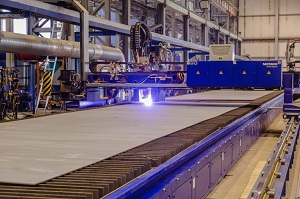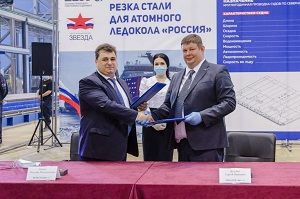Zvezda Shipyard Launches Construction of the World’s Most Powerful Nuclear Icebreaker
-350x1000.jpg)
The Zvezda Shipbuilding Complex has launched the construction of the flagship nuclear icebreaker of the Leader project. Cutting of the first hull details for the future vessel has taken place in the hull production block of the shipyard. The flagship icebreaker has been named ‘Russia’.
This vessel will become the most powerful atomic-driven ship in the history of the world shipbuilding. This technically challenging project has no rivals throughout the world. Its key task is to provide year-round escort for the commercial fleet along the Northern Sea Route. The Leader project will become the basis for a new generation of the Russian icebreaker fleet.
 The contract on the icebreaker construction was signed between the Zvezda Shipbuilding Complex and the Atomflot Federal State Unitary Enterprise on April 23, 2020. The state contractor of the icebreaker is Rosatom. The Zvezda Shipbuilding Complex was chosen as the sole executor of this contract according to the decision of Russian President Vladimir Putin. The completion of the icebreaker construction is scheduled for 2027.
The contract on the icebreaker construction was signed between the Zvezda Shipbuilding Complex and the Atomflot Federal State Unitary Enterprise on April 23, 2020. The state contractor of the icebreaker is Rosatom. The Zvezda Shipbuilding Complex was chosen as the sole executor of this contract according to the decision of Russian President Vladimir Putin. The completion of the icebreaker construction is scheduled for 2027.
The Iceberg Central Design Bureau is developing the design documentation for the Phase Zero of the project. The related contract was concluded with the Zvezda Shipbuilding Complex in 2019.
The new ship is 210 metres long, 47 metres wide, and its draught is 13 metres. The Russia icebreaker will be equipped with two RITM-400 type nuclear reactors, four turbines and four electric propulsion motors. Power plants of the icebreaker with a total capacity of 120 MW will allow the vessel to break the ice more than 4 metres thick at a speed of 2 knots. With an ice thickness of 2 metres, the speed of the icebreaker will be up to 12 knots.
 The nuclear-powered ship will be able to make a way about fifty metres wide, providing an opportunity for cost-effective year-round navigation of transport vessels with carrying capacity over 50 thousand tonnes, as well as gas carriers of Arc7 class with a hull width of 50 metres along the Northern Sea Route. Before the Leader icebreaker is put into operation, transport ships will be guided through the NSR by nuclear-powered icebreakers with a maximum capacity of 60 MW.
The nuclear-powered ship will be able to make a way about fifty metres wide, providing an opportunity for cost-effective year-round navigation of transport vessels with carrying capacity over 50 thousand tonnes, as well as gas carriers of Arc7 class with a hull width of 50 metres along the Northern Sea Route. Before the Leader icebreaker is put into operation, transport ships will be guided through the NSR by nuclear-powered icebreakers with a maximum capacity of 60 MW.
The Zvezda Shipbuilding Complex is constructed by the Rosneft-led Consortium upon the instruction of President of Russia Vladimir Putin. The Shipyard’s order portfolio amounts to 39 vessels (59 vessels including options) at the moment. The Shipyard’s pilot throughput is provided for by Rosneft that placed an order for 28 vessels. Zvezda’s product line will include vessels of up to 350,000 tonnes displacement, components of marine platforms, ice-class vessels, commercial vessels for cargo transportation, specialty vessels, and other types of marine equipment of any complexity, characteristics and purposes, including those that had not previously been produced in Russia due to the lack of required launching and hydraulic structures.
Note for Editors:
The construction of Zvezda is carried out in two stages. The following facilities of the first extended stage have been put into operation: the hull production block, painting cabinets, the open heavy outfitting slipway equipped with a park of unique cranes and a state-of-the-art ship transportation system, and the floating transfer dock.
The workshops built enabled the construction of a number of ships before the completion of the second stage. Commissioning of the second stage will expand the shipyard’s capabilities and allow Zvezda to build vessels and marine equipment without any limitations. The second stage comprises the following: a dry dock and additional full-cycle production shops for construction of large-capacity vessels and marine equipment. The shipyard overall completion is scheduled for 2024.
Zvezda’s product line includes tankers, gas carriers, drilling platforms, and ice class ships, including the world’s most powerful nuclear icebreakers, the Leaders. The Zvezda Shipbuilding Complex will rival foreign shipyards and provide Russia with a civilian fleet to develop offshore fields and smoothly operate the Northern Sea Route--the shortest route between Europe and Asia.
The slip has already been equipped with two portal jib cranes with a lifting capacity of 320 tonnes, four gantries with a lifting capacity of 100 tonnes, and a unique Goliath crane with a lifting capacity of 1,200 tonnes. The lifting capacity of cranes in other Russian shipyards, in contrast, is only 500 tonnes.
The state-of-the-art floating transfer dock called Vympel is the most important unit at the shipyard. It ensures that the Zvezda Shipbuilding Complex is manufacturing ships which could not have been built at other Russian shipyards before. The dock is unsupported and allows carrying out the longitudinal launching of ships from three different shipyard slipway lines as well as the sideways launching of offshore facilities.
The floating transfer dock is designed for heaving off large-sized marine vessels 300 metres in length and over 50 metres in width, as well as marine equipment, like drilling platforms and their pieces, and ensures high quality and safety of the launch.
The shipyard has about 3,500 employees at the moment, 87% of whom live in Primorsky Territory. By 2024, when the construction of all facilities is to be finished, the number of employees will have surpassed 7,000. The shipyard works intensively on stuff recruitment and re-skilling, the social infrastructure development in Bolshoy Kamen and the construction of apartment blocks for employees. 10 buildings are already finished and lived in, and there is an active real estate development in six subdistricts. In general, by 2023, it is planned to build about 2023 flats and meet the employees’ housing demands completely.
Rosneft
Information
Division
July 6, 2020